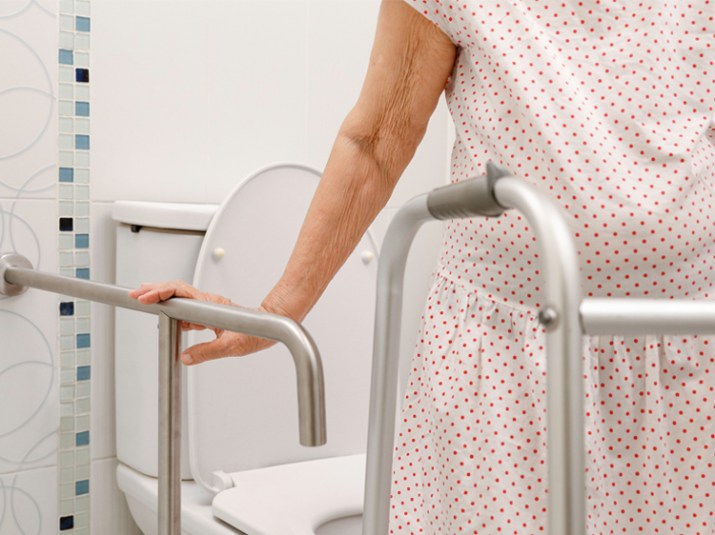How to Make Your Home Safer for an Elderly Parent

For many adults today, having a senior, often ailing parent, means moving them into their own homes to better look after them. In fact, there are 34.2 million Americans providing unpaid care to an adult aged 50 or older each year, according to the National Alliance for Caregiving and AARP.
If you’re about to begin looking after Mom, Dad, or both, you may find that it’s not as easy as installing a queen-sized bed in a spare room and calling it a day. Instead, when an elderly parent moves into your home, there are certain modifications you’ll likely need to make so it’s a safe environment for them.
“The physical space is what comes to mind first for most people,” says Danielle Arigoni, Director, AARP’s Livable Communities. “That means asking, ‘How can we ensure that the physical layout and attributes in a home can provide for a safe, accessible, and enjoyable way to live?’ Sometimes the changes that are needed are surprising ones, and bigger fixes may also be necessary.”
Before calling in a contractor and making major and expensive changes, Arigoni recommends first poking around to see where you might easily modify your home to make it safer and more comfortable for Mom or Dad.
1. Start With The Small Stuff
Simple fixes include moving light switches and door handles so they are reachable from a wheelchair or a bed, clearing electrical cords, removing wheels on chairs, and moving small and low furniture out of the way of busy passageways.
Falls are often a concern. Each year, more than one out of four older people fall, with 20 percent of these resulting in a serious injury such as broken bones or a head injury, according to the Centers for Disease Control and Prevention (CDC). To prevent this from happening to your folks, you’ll want to focus on removing throw rugs and inspecting carpeting for up-turned corners, put non-skid tread on steps, nonslip wax on floors and no-slip strips in bathtubs and showers, and using rubber-backed bathmats to help prevent slips and falls.
2. Keep Things Illuminated
Proper lighting is an area many folks often overlook.
Older people may need brighter lights in hallways, closets and stairwells, nightlights in bedrooms and bathrooms, and well-lit outdoor pathways and garages. Arigoni suggests adding extra lamps to rooms that are regularly used, and to look for models that can be turned on and off with a touch, as opposed to forcing Mom and Dad to fiddle with a small knob that may be difficult to reach and operate.
“Small changes like these can go a long way in easing elderly parents into a new home,” says Arigoni.
3. Know When To Consult An Expert
When it comes to larger fixes, you may consider hiring an occupational therapist, physical therapist, geriatric care manager, or another certified aging-in-place specialist. Ask experts to come to your home to access its safety and recommend modifications or remodeling projects that will make it easier for Mom and Dad to live there.
Depending on your parents’ health and mobility, you may need to refit entryways and widen doorways. Doing so will allow those in a wheelchair or who use a walker to easily travel from room to room, and to enter and exit the home. Some homeowners may find they need to switch out their top-loading washer/dryer with a front-load pair, even putting them on a riser so Mom and Dad don’t have to bend over to wash their clothes.
In the kitchen, you might install pull-out shelving under counters or lazy Susans in corners to make using cookware or reaching for spices and Tupperware easier. You could also consider replacing round knobs with easy-to-grasp D-shaped pulls. If your parents are comfortable cooking, install enough back- and under-cabinet lighting to illuminate the sink, stove, and cooking surfaces. If you have a parent in a wheelchair, or one who can’t stand for long periods of time, Arigoni recommends installing a surface where one can work while seated. You don’t have to remodel your entire kitchen to do this: You may opt for a small table, installing a pull-out work surface or removing lower cabinet doors and shelves to accommodate a wheelchair or dining chair.
4. Don’t Ignore The Bathroom
Often overlooked, the bathroom can be a minefield of accidents for the elderly with its slippery floors and confined spaces.
“In some cases, new bathroom fixtures may be necessary,” says Arigoni, “which can be designed to be beautiful as well as functional.”
Such modifications include installing a higher, comfort-height toilet, and easy-to-use lever handles in place of knobs or turn handles on the sink, bathtub, and shower faucets.
Older adults often benefit from “grab bars” in the bathtub and shower, and that are adjacent to the toilet so they can pull themselves up from a sitting position or steady themselves while on slippery flooring. To make sure the bars don’t come out of their foundations, you may need to reinforce the walls into which they are affixed with wood studs or another solid surface.
You may discover your parents could benefit from a seat or bench in the shower, so they can bathe while sitting, as well as a handheld or adjustable showerhead. Depending on your folks’ mobility, you may need to re-engineer your bathroom to accommodate a step-in shower or bathtub.
Arigoni says that to help prevent falls, replace any bathmats or rugs with those that are rubber-backed or secured with double-sided rug tape or rubber carpet mesh.
Finally, says Arigoni, “it’s important to remember that life happens outside the home, too. Think about what opportunities your neighborhood provides in terms of walkable, bike-able destinations. Are there schools, parks, restaurants, shops, pharmacies, and other services in close proximity? If yes, acquaint yourself with them, get comfortable with the walk or bike there, and begin to make those a part of the whole family’s life so that your elderly parent can share in those opportunities — with or without you.”
More From FIRST
Under One Roof: How to Keep the Peace in a Multigenerational Household
Married Couples Who Say ‘We’ a Lot Are Happier and Healthier, Say Experts
How to Kindly and Effectively Talk to an Older Relative About Giving Up the Keys for Good













